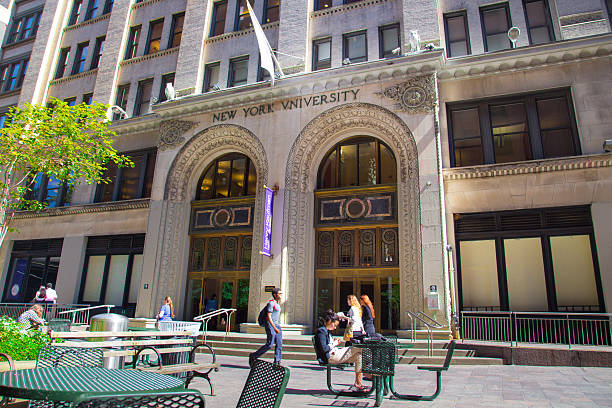Massachusetts Institute of Technology-MIT
The Massachusetts Institute of Technology (MIT)

The Massachusetts Institute of Technology is the best and most prestigious higher education institutions in the United States. It is a privately owned and operated business in the city of Cambridge, Massachusetts. During the industrial revolution, the university was established to meet the demand for highly skilled workers, managers, and entrepreneurs.
MIT’s educational system is based on the polytechnic university model, which is common in European universities, and it emphasises applied science and engineering through laboratory instruction. MIT researchers contributed to the war and peace efforts during WWII and the Cold War. They contributed to the advancement of radar, computer, and inertial guidance systems for military use. Because of the extensive post-war defence research conducted by its faculty, the university experienced phenomenal growth following World War II.
Also read: Best Dental School in the world
MIT is made up of five schools and one college, with 32 academic departments. While MIT is not the top-ranked university in the country, many would argue that it is just as good, if not better, than its competitors. While MIT is best known for its science and engineering programmes, it now also has top-ranked research and education programmes in economics, business management, biology, and linguistics.
The university is also known for its entrepreneurial culture, having produced many of America’s top entrepreneurs and business owners. In fact, the total revenue generated by businesses founded by MIT graduates exceeds the revenue generated by the world’s 11th largest economy.
Academics
MIT is primarily a research university that caters to graduate and professional students’ educational needs. The New England Association of Schools and Colleges has regionally accredited it.
Electrical Engineering and Computer Science (EECS), also known on campus as “Course 6,” is the most popular department at MIT. In fact, all majors and classes at MIT are identified solely by an acronym or number. Students, for example, refer to Linguistics and Philosophy as Course 24, Civil and Environmental Engineering as Course 1, and so on. Individual courses are identified by a combination of the course number and class number assigned by the department. The Mechanical Engineering Dynamics and Control II course, for example, is also known as 2.03.
MIT has a four-year undergraduate programme that focuses on professional majors with a few arts and sciences courses. MIT offers undergraduate students a choice of 44 degree programmes through its five academic schools. MIT only confers the bachelor of science degree at the undergraduate level (SB). Approximately 63 percent of undergraduate students major in engineering. Science (29 percent), humanities, business management, and architecture are also popular undergraduate majors. Electrical engineering and computer science are the two most popular undergraduate degrees. Mechanical engineering, mathematics, mechanical engineering, and computer science and engineering are also popular undergraduate degrees.
A typical MIT undergraduate class consists of lectures, problem sets, recitations, and exams. Despite the fact that keeping up with the learning pace as an undergraduate at MIT is difficult and challenging, the school has a freshmen retention rate comparable to other top universities. Many students are relieved that the school uses a “pass/no record” grading system, given the difficulty level of undergraduate coursework.
The graduate and undergraduate programmes at MIT coexist harmoniously. Many classes, in fact, include both undergraduate and graduate students. MIT’s doctoral programmes are focused on STEM fields, but they also offer programmes in the social sciences, humanities, and various professional disciplines. Master of Science (MS), Doctor of Philosophy (PhD), Master of Business Administration (MBA), Master of Finance (MFin), Master of Architecture (MArch), Master of Engineering (MEng), and Master of Science in Real Estate Development are among the graduate degrees offered at MIT (MSRED). At the graduate level, MIT also offers a variety of interdisciplinary degrees.
Candidates who want to attend one of MIT’s graduate programmes must apply directly to the department that offers the degree they want. The vast majority (over 90%) of doctoral students at MIT are supported by research assistantships, teaching assistantships, or fellowships. The School of Engineering is home to nearly half of all graduate students. The Sloan School of Management and the School of Science are MIT’s next two most popular graduate schools.
Rankings
MIT is consistently ranked as one of the best universities in the United States. Individual schools and programmes at the university are also ranked among the best in the country. For several years, U.S. News & World Report, the Academic Ranking of World Universities, and QS World University Rankings have ranked MIT’s School of Engineering as the best in the country. Computer science, engineering, business, natural science, linguistics, economics, and mathematics are among the top ten programmes at MIT. Philosophy and political science are two other top-ranked graduate programmes.
Sloan Management School
The Massachusetts Institute of Technology’s Sloan School of Management offers a two-year MBA programme for aspiring business managers, leaders, and entrepreneurs. The case study method of teaching and learning is used in the programme, which is supplemented by in-class discussions, hands-on labs, lectures, and interaction with industry leaders. Students complete courses in economics, business statistics, accounting, managerial communication, organisational processes, marketing, and finance in teams during their first year. The purpose of the first year is to develop skills in the fundamental processes and gain the basic business knowledge required to manage a business.
During the second year of the MBA programs students are able to work on their own as they focus on specialized area of study in line with their longer term career goals.
Programs for Undergraduates
Degrees in Multiple Subjects
Biology and chemistry (Course 5-7)
Cognition and computation (Course 6-9)
Molecular Biology and Computer Science (Course 6-7)
Economics, computer science, and data science (Course 6-14)
The humanities (Course 21)
American Studies, Ancient and Medieval Studies, Asian and Asian Diaspora Studies, Latin American and Latino/a Studies, Russian and Eurasian Studies, Women’s and Gender Studies
Engineering and Humanities (Course 21E)
African and African Diaspora Studies, American Studies, Ancient and Medieval Studies, Anthropology, Asian and Asian Diaspora Studies, Comparative Media Studies, Global Languages (in French, German, or Spanish), History, Latin American and Latino/a Studies, Literature, Music, Russian and Eurasian Studies, Science, Technology, and Society, Theater Arts, Women’s and Gender Studies, Writing Humanities and Science are among the Humanities fields available (Course 21S)
African and African Diaspora Studies; American Studies; Ancient and Medieval Studies; Anthropology; Asian and Asian Diaspora Studies; Comparative Media Studies; Global Languages (in French, German, or Spanish); History; Latin American and Latino/a Studies; Literature; Music; Russian and Eurasian Studies; Science, Technology, and Society; Theater Arts; Women’s and Gender Studies; Writing Urban Science and Planning with Computer Science are among the Humanities fields available (Course 11-6)
Minors in Interdisciplinary Studies
Studies on Africa and the African Diaspora
Ancient and Medieval History
International Studies in Practice
Asian and Asian Diaspora Research
Atmospheric Chemistry and Astronomy
Engineering in Biomedicine
Energy Research
Environment and Sustainability Entrepreneurship and Innovation
Latino/a and Latin American Studies
Studies in the Middle East
Public Policy on Polymers and Soft Matter
Eurasian and Russian Studies
Data Science and Statistics
Gender and Women’s Studies
Also read: Cheapest Medical Schools in Texas
General Bachelor of Science Degree Requirements Undergraduate Degree Charts
Architecture School and Planning Architecture (Course 4)
Design and Art (Course 4-B)
Preparation (Course 11)
Aerospace Engineering School of Engineering (Course 16)
Materials and Archaeology as Recommended by the Department of Materials Science and Engineering (Course 3-C)
Engineering in Biology (Course 20)
Biological-Chemical Engineering (Course 10-B)
Engineering in Chemistry (Course 10)
Chemical Engineering as Recommended by the Chemical Engineering Department (Course 10-C)
Engineering and computer science (Course 6-3)
Computer Science and Electrical Engineering (Course 6-2)
Engineering and Electrical Science (Course 6-1)
Inventive+ paraphrase (Course 1-ENG)
Inventive+ paraphrase (Course 2-A)
Inventive+ paraphrase (Course 10-ENG)
Inventive+ paraphrase (Course 16-ENG)
Inventive+ paraphrase (Course 22-ENG)
Engineering and Materials Science (Course 3)
Engineering and Materials Science (Course 3-A)
Ocean and mechanical engineering (Course 2-OE)
Engineering, Mechanical (Course 2)
Nuclear Engineering and Science (Course 22)
Anthropology at the School of Humanities, Arts, and Social Sciences (Course 21A)
Media Studies in Comparison (CMS)
The economics (Course 14-1)
Languages and Global Studies (Course 21G)
The Past (Course 21H)
The humanities (Course 21)
Engineering and Humanities (Course 21E)
Science and Humanities (Course 21S)
Philosophy and Linguistics (Course 24-2)
The written word (Course 21L)
Economic Mathematics (Course 14-2)
Music (Course 21M-1)
The philosophy (Course 24-1)
The study of politics (Course 17)
Second Major in Science, Technology, and Society (STS)
Theatrical Arts (Course 21M-2)
Composing (Course 21W)
Business Analytics at the Sloan School of Management (Course 15-2)
Budgeting (Course 15-3)
Administration (Course 15-1)
Biology Department, School of Science (Course 7)
Cognitive and Brain Sciences (Course 9)
The chemistry (Course 5)
Sciences of the Earth, Atmosphere, and Planets (Course 12)
arithmetic (Course 18)
Combining Mathematics and Computer Science (Course 18-C)
Theoretical Physics (Course 8)
Computer Science and Engineering at MIT’s Schwarzman College of Computing (Course 6-3)
Computer Science and Electrical Engineering (Course 6-2)
Engineering and Electrical Science (Course 6-1)
Chemistry and Biology Interdisciplinary Programs (Course 5-7)
Cognition and computation (Course 6-9)
Molecular Biology and Computer Science (Course 6-7)
Economics, computer science, and data science (Course 6-14)
Urban Science and Planning in conjunction with Computer Science (Course 11-6)
Also read: Best Educational podcast
Diagrams of Graduate Degrees
Degree charts for several graduate programmes are provided below. For information on graduate programmes, consult the departmental chapters, and the Graduate Education Section for general Institute requirements for graduate degrees.
Art, Culture, and Technology at the School of Architecture and Planning (SMACT)
Engineering School Electrical Engineering and Computer Science (Course 6-P)
PhD/ScD Programs in Aeronautics and Astronautics
Biological Engineering PhD/ScD
Nuclear Science and Engineering PhD/ScD
Data, Economics, and Development Policy at the School of Humanities, Arts, and Social Sciences
PhD Brain and Cognitive Sciences Fields at the School of Science
PhD/ScD Programs in Earth, Atmospheric, and Planetary Sciences
Computation and Cognition Interdisciplinary Programs (Course 6-9P)
Molecular Biology and Computer Science (Course 6-7P)
Property Development
Statistics
Management of the Supply Chain
Policy and Technology
Transportation



